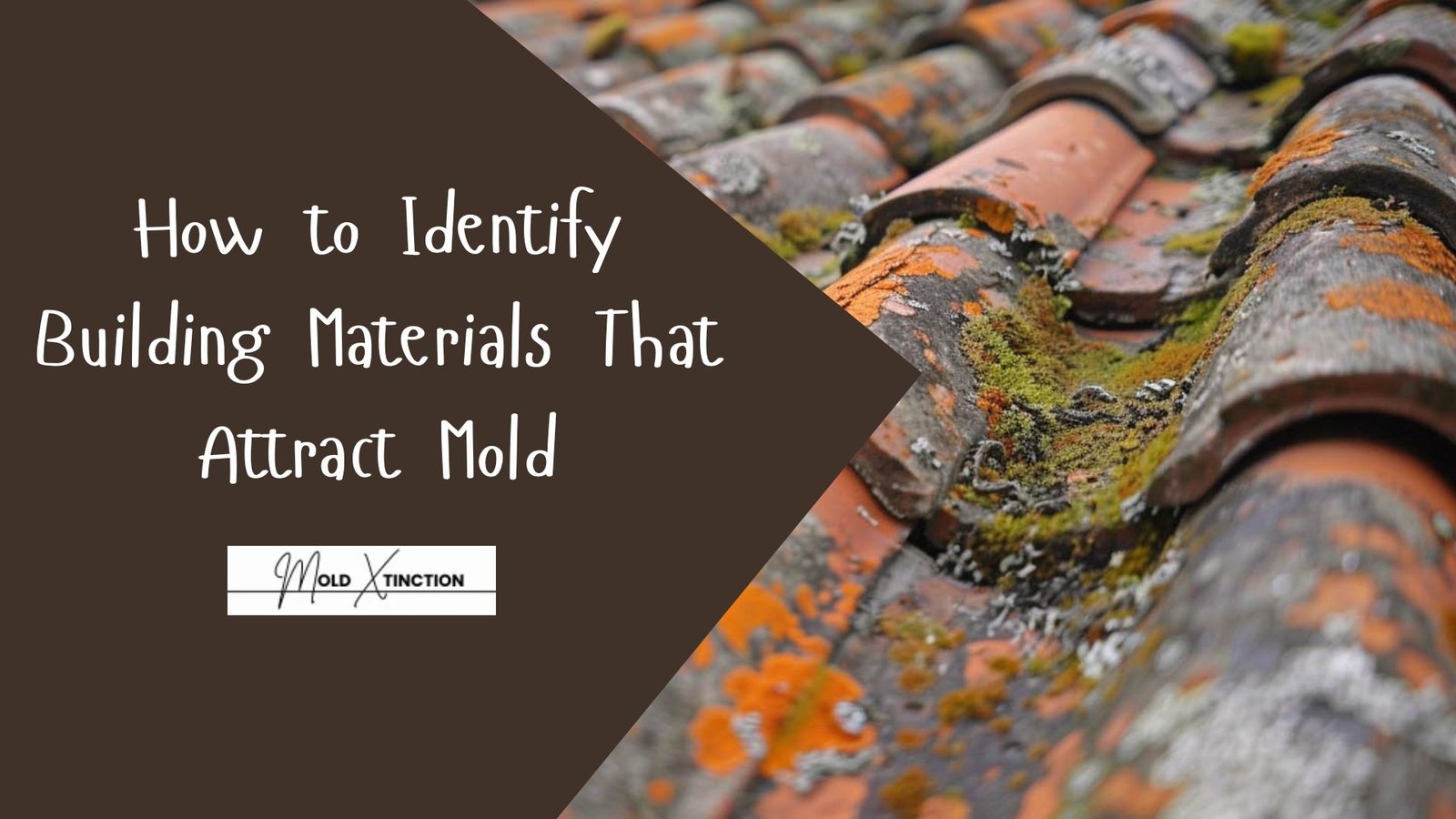Knowing how to identify building materials that attract mold is very important. This will help prevent mold from attacking your building.
Mold may grow in a variety of materials, but there are certain building materials that allow mold growth and proliferation. Such materials retain moisture, and mold requires moisture, warmth, darkness, and food to survive.
Without dealing with it, mold can turn into a serious problem to your well-being and the well-being of your home. That is why one needs to know the way to find these materials.
In this article, we are going to discuss the building materials on which the molds grow, how these materials can be identified, and the simple measures you can follow to ensure that your home is not infested with mold.
What's In This Article
ToggleHow to Identify Building Materials That Attract Mold

Here are some common building materials that mold loves to grow on:
1. Drywall (Gypsum Board)
One of the most commonly used building materials in a home is drywall. This sheet is made of material called gypsum and is covered with paper. Mold thrives on this layer of paper, especially when wet. If the moat is humid, there may be water leaks and flooding or high indoor moisture levels; this means the drywall will absorb this moisture. When that happens, it can be covered by mold in 24 hours.
Look for:
- Dark spots or stains
- Soft or bubbled surface
- Musty smell
Tip: Dry wet drywall quickly. If it stays wet too long, you may need to replace it.
2. Wood and Plywood
Wood is an organic material and one thing about it is that it’s prone to mold. When wood is wet, it tends to absorb and retain moisture which provides the perfect condition for mold growth. Floors, wall frames, furniture and wall panels are particularly vulnerable after leaks, flood or high moisture. If not addressed immediately, the mold can spread into the wood leaving stains, odor and eventually weakening the structure.
Causes:
- Roof leaks
- Plumbing leaks
- Poor ventilation
Watch for:
- Green, black or white spots
- Warped or soft wood
- Odors that smell like earth or rot
Tip: Use treated wood for damp areas like basements or bathrooms.
3. Insulation (Especially Fiberglass)
Walls, attics and ceilings are insulated to keep your house warm during cold season and cool during hot days. But there are types of insulation that can trap moisture in case of a leak or over-humidity such as fiberglass or foam. A little bit of water in the insulation is an ideal breeding ground for mold. Insulation mold is hard to spot and needs to be removed and replaced most of the time to prevent spreading.
Especially prone areas:
- Attics
- Crawl spaces
- Walls behind leaking pipes
Warning signs:
- Unusual smells in the walls
- Cold spots or damp insulation
- Allergy-like symptoms indoors
Tip: Replace wet insulation. It can’t be dried and reused.
4. Carpet and Padding
Carpet and padding is a natural trap for moisture when there are spillages, leaks or water inundation. When this moisture doesn’t dry out quickly it soaks into the layers and provides a dark damp environment for mold to grow without you noticing. Although the surface may look clean, mold can be growing behind. This can cause bad odours, health issues and a company will have to strip the carpet to fix the situation.
Look out for:
- Squishy spots
- Colour changes
- Musty smells when you walk on it
Tip: Dry wet carpets within 24 hours. Otherwise it may have to be removed.
5. Ceiling Tiles
Ceiling tiles are made of materials like wood fibers or mineral sheet all of which are food for mold. It usually contains these tiles where there is moisture gathered mostly under leaking roofs or where there are air conditioning units. The tiles will absorb moisture when wet or in high humidity and start growing mold. This will result to discoloration, sagging and offensive odours within the ceiling space.
Signs include:
- Brown water stains
- Sagging or bending
- Mold spots on tile surface
Tip: Replace any stained tiles quickly. Check the area above them for leaks.
6. Wallpaper and Paint
In wallpaper and paint, moisture can be trapped by hiding it under a covering. When the wall behind them is wet due to leakages or high moisture levels, mold may start growing behind the scenes. The moisture creates a gap that can’t be seen by the naked eye where the mold can grow in-between the wall and the surface over time. You may see peeling, bubbling or discoloration which are definite signs that mold may be growing behind the paint or wallpaper.
What to watch for:
- Peeling or bubbling wallpaper
- Discoloration or streaks
- Wall feels soft or damp to touch
Hint: When there is peeling paint or you get the smell of mold, look under that. Don’t just repaint over the problem.
Less Obvious Places Where Mold Can Grow
Mold doesn’t only grow in walls or carpets. Here are other materials and areas to check:
- House and furniture (particle board)
- Heavy walls (not sealed properly)* Wooden window sills
- HVAC (duct and vent)
These don’t look dangerous at first but if there’s moisture, mold will get in.## How to Prevent Mold on These Materials
First you need to know the materials that are prone to mold. So you must keep those materials dry and clean to ensure your home is really safe. Here’s how:
1. Fix Leaks Fast:
Check your roofs, windows, sinks and pipes regularly to notice any water leakages. A small trickle can seep into a wall or ceiling and mold can grow unseen.
2. Use a Dehumidifier:
Dehumidifier helps in controlling the moisture in areas like basement of the house or bathroom. Low humidity will prevent mold from growing.
3. Ventilation:
As much as possible open your windows and use fans to circulate air in your house. Wet places will dry off and no mold will grow with good air circulation.
4. Choose Mold Resistant Materials:
Choose drywalls, paints and insulation materials that are mold resistant. They are suitable for high moisture areas like kitchen, laundry and bathroom.
5. Check Dark Spaces:
Mold can be in places not visible to the eye: behind a sofa, under a sink or in different closets. Always check these areas every few weeks.
How to Know If Mold Is Already There
Sometimes mold is not visible and this is when it’s behind the walls or below the floors. But there are other signs to detect it. The most obvious sign is the strong musty smell which often betrays the presence of mold even if there are no visible spots and stains on the surface at the moment.
These are the signs:
- Heavy mouldy smell
- Increasing allergies or coughing
- Air contains moisture
- Presence of Stains or color alteration on walls, ceilings or floors
Be aware of these and act fast. The longer mold stays the more damage it can cause.
Can You Remove Mold Yourself?
Occasional mould on tiles or counter tops can be removed with vinegar, baking soda or mould cleaner. But when it’s deeper in the walls, under the floors or in air systems then mould has a bigger problem. These moulds are hidden and hard to reach; they can spread fast. Trying to remove deep mould yourself may not work and can even make the situation worse and spread the mould spores.
When you try to get it off yourself:
- You won’t see the hidden mould
- The spores will find their way to clean areas
- You’re putting yourself in danger
Call a Professional Remediation Service (Your Best Option)
But when it comes to mold, the best thing to do is to call in a professional remediation service as it is the safest and most effective thing to do. Where specialists have the right tools, knowledge and protective gear, they can find mold, remove it and stop it. Trying to clean up yourself may cause some health hazards and partial clean up.
- Experts in this will help you to:
- Find mold that’s out of sight
- Take it out without a hitch
- Prevent it from coming back
- Save your health and property. Don’t wait.
Conclusion
It doesn’t take long for regular construction materials like drywall, wood, insulation and carpet to grow mold when exposed to water. These materials can trap water, maybe from leaks, floods or even moisture and it’s a perfect environment for mold to grow. Once it starts to spread it can ruin your property and even your health.
So you must be aware of what to look out for. Look for spots, musty odours, flaking paint or spongy places. Fix the leaks, get the wet situations dry and bring in more fresh air in the room to prevent mold.
But remember- no matter how good your intentions are mould might be lurking in the walls or under the floors. If you suspect some mould you should not try to do anything about it yourself or if you’re not sure what caused the mould. Call a mould removal cleaning company.
They have the right equipment and skills to identify the mould and remove it safely and make sure they don’t resurrect. There’s no time to waste. Your health, your home and your peace are at stake.
Helpful Guide: How Humid Weather Increases Mold Growth in Buildings


